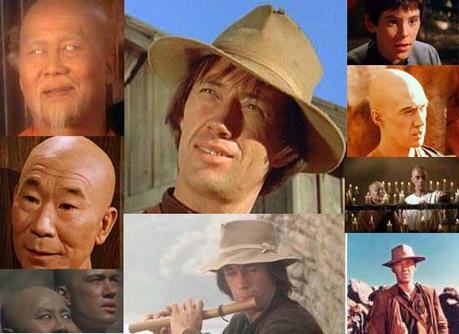The actor David Carradine may have led a troubled life but he experienced no such trouble as Kwai Chang Caine, a Buddhist monk on the move in the old American west. From 1972-1975, the Kung Fu series was must watch television for kids my age, even if we had no idea that Caine was a Shaolin Temple monk trained in the cool arts of Zen. Despite some absurd juxtapositions, Grasshopper brought some much needed serenity and justice to the wild west.

Jamil Anderlini of the Financial Times recently visited Shaolin for an interview with its controversial abbot, Shi Yongxin. When asked about the subservience of religion to the state in China, the abbot responds: “Throughout history it is the same: Religion must respect the emperor, respect the government. If a religion doesn’t respect the government, it will have difficulty surviving. We have to rely on the government to publicize and promote us.” Anderlini’s impression is that the abbot sounds “like an executive from a global marketing firm.”
Perhaps, but I think the abbot sounds more like an astute historian and pragmatist. Since the rise of the Shang Dynasty in 1766 BCE, religion and government in China have been tightly linked. While some have claimed that later dynasties were essentially secular, most claims of this sort focus on Confucian legalism and court intellectuals; they minimize the large and important role that religion played in maintaining the realm and legitimating rulers.
In “The Religious Commitment: Shang Theology and the Genesis of Chinese Political Culture,” historian David Keightley explains the connections:
Shang religion was inextricably involved in the genesis and legitimation of the Shang state. It was believed that Ti, the high god, conferred fruitful harvest and divine assistance in battle, that the king’s ancestors were able to intercede with Ti, and that the king could communicate with his ancestors.
Worship of the Shang ancestors, therefore, provided powerful psychological and ideological support for the political dominance of the Shang kings. The king’s ability to determine through divination, and influence through prayer and sacrifice, the will of the ancestral spirits legitimized the concentration of political power in his person.
There were similar developments around the world, which varied according to time and place. Wherever we find newly organized or rising city-states, we find that religion is married to power. Keightly recognizes this: “There is nothing uniquely Chinese in this account so far. Religious belief has played similar roles in the genesis of other states.” While coercion can provide a measure of control in larger-scale societies, having people internalize power — or exercising “self control” — is far more effective.
Although these kinds of arrangements eventually broke down in many parts of the world (thus setting the stage for the Axial Age), in China they were transformed and reinvigorated (in large part by Confucian ideas). There has been a great deal of continuity in China for the last 3,000 years. The names may change, but the basic ideas are incredibly resilient.
Reference:
Keightley, David N. (1978). The Religious Commitment: Shang Theology and the Genesis of Chinese Political Culture History of Religions, 17 (3/4), 211-225



